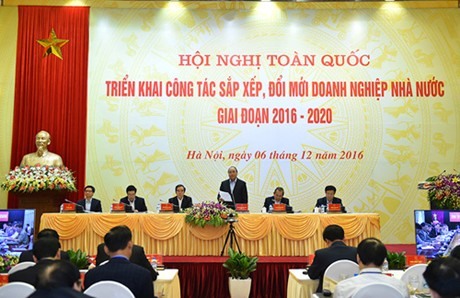 Politics & Law
Politics & Law

Prime Minister Nguyễn Xuân Phúc yesterday stressed the importance of preventing State asset losses while State-owned enterprises (SOEs) are equitised and called into question the individual accountability of SOE leaders in deliberately delaying the process.
 |
| Prime Minister Nguyễn Xuân Phúc (standing) chaired the National Conference on Reorganisation and Restructuring of State-owned Enterprises for the 2016-2020 period held in Ha Noi yesterday afternoon. - Photo BaoChinhPhu.vn |
HÀ NỘI – Prime Minister Nguyễn Xuân Phúc yesterday stressed the importance of preventing State asset losses while State-owned enterprises (SOEs) are equitised and called into question the individual accountability of SOE leaders in deliberately delaying the process.
His comments came as he chaired the National Conference on Reorganisation and Restructuring of State-owned Enterprises for the 2016-2020 period held in Hà Nội.
Deputy Chairman of the Government Office and Deputy Head of the Steering Board for SOE Renovation and Development, Lê Mạnh Hà, delivered a summary of SOE restructuring efforts during the 2011-2015 period.
He said that in general, the targets had ‘basically’ been achieved, though mismanagement resulted in debts and ineffective performance.
After 15 years, the number of SOEs has dramatically decreased from some 6,000 in 60 sectors in 2001 to just 718 in 19 sectors by the end of this October.
The cutback has been centred on the small or inefffective firms operating in sectors that don’t require State control, according to the report.
For the coming five years, the Government has narrowed down areas where the State needs to have a 100 per cent stake, limiting it to fields of strategic importance like infrastructure, national defence, hi-tech adoption, large-scale investments, creation of socio-economic impetus in areas that lack investment from other sources.
SOEs still account for the largest contribution – 28.8 per cent – to the State budget, compared to 11.8 per cent from private enterprises and 17.9 per cent from FDI enterprises.
In the last five-year period, 499 SOEs have been equitised, reaching 96.3 per cent of the five-year plan.
However, 25 State-owned enterprises (SOEs) have incurred debts as large as three times their equity. The most serious offenders in this regard are the Broadcast Information Development Corporation (EMICO) with debt/equity ratio reaching 33, Military Petroleum Corporation (MIPECO) with 17:13, and Corporation 36 with 15.41.
“Post-equitisation, market capitalisation of SOEs has reached a mere eight per cent, the remaining 92 per cent is still owned by the state holders. Thus, I ask all ministries and local authorities as well as corporations to look into this phenomenon and devise appropriate remediation measures soon,” Phúc said.
He also demanded the acceleration of restructuring in the coming period, with emphasis on the SOE reform process becoming faster, stronger and more transparent, in line with market mechanisms, and avoiding loss of state assets.
“Attention must be given to issues that arise from equitisation of large SOEs, for example, post-equitisation performance, selecting foreign strategic investors, the qualifications and responsibilities of consultant organisations that are tasked with SOEs’ equity valuation,” Phúc said.
“The Auditor General told me about this case where there’s a difference of VNĐ10 trillion (US$440 million) between consultants’ evaluation and the State auditing agency’s evaluation,” he noted.
Trần Quang Nghị, Chairman of Textile and Garment Corporation, blamed the slow equitisation on “outdated mindsets” among some SOE directors wanting to use State capital without “having to worry about competition in the market.”
A representative from State Capital Investment Corporation proposed a ‘facilitative’ environment that allows SOEs to compete fairly with enterprises from other economic sectors, and requested that SOEs be allowed to operate in areas ‘not prohibited by law’ instead of ‘areas allowed by the law.”
The heads of many ministries including Finance and Trade and Investment, leaders of federal municipalities, and heads of SOEs attended the conference via video-conferencing. – VNS




